Fact Sheet FS1251
Bed bugs, (Cimex lectularius L.), have gradually become a common urban pest in the past decade. People get bed bugs in various ways such as visiting an infested place, bringing in infested furniture, or through the natural dispersal of bed bugs from an infested neighboring room within a multi-occupancy dwelling such as an apartment building. Many people try to control bed bugs themselves to avoid the expense of hiring a professional service, however, professional services offer the advantage of a technician who is properly trained in pesticide safety and effective bed bug management. Although professional pest control services usually are more effective, for those who still wish to control bed bugs on their own, we provide a summary of the cost-effective versus money-wasting materials and methods. This information will help you combat bed bugs safely and effectively.
What Works
- Reduce clutter or put items in plastic boxes
- Encase mattress and box spring
- Install bed bug traps
- Launder or hot dry bed linens at least weekly
- Use a heat chamber
- Place small items in a freezer for 4 days
- Apply steam to furniture
- Remove bed bugs using a vacuum machine
- Discard heavily infested items
- Apply repellent to pants, socks, and shoes
What Doesn't Work
- Switch sleeping location
- Ultrasonic pest repeller
- Dryer sheets and plant oil-based repellents
- Moth balls
- Rubbing alcohol
- House cleaning materials
- Most natural pest control products
- Foggers
- Most consumer pesticide sprays
Cost-Effective Bed Bug Control Materials and Methods (What Works)
- Place Items in Plastic Containers or Plastic Bags Zoom in(Figure 1). This is a simple and cost-effective way to keep bed bugs out of materials and improve the speed of control in a room. Bed bugs do not like to climb or stay on smooth plastic materials. Placing small items in plastic containers or in sealed heavy-duty plastic bags will prevent bed bugs from infesting the items. In an infested home, placing clutter in plastic containers will make bed bug elimination efforts easier. Treat items already infested before storing. Effective methods for treating infested items include hot laundering, steaming, heating, or freezing (each is discussed below).
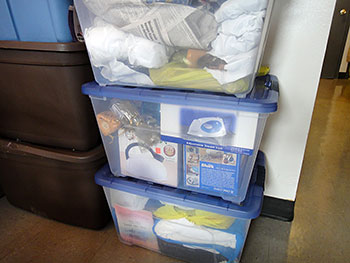
Figure 1.
- Mattress and Box Spring Encasements. Zoom inInstalling encasement (Figure 2) will reduce bed bug populations immediately, eliminate many harborages, and make bed bug inspection much easier. If budget is a concern, a vinyl encasement that costs $5–10 a piece can be used, however vinyl encasements easily rip or tear.
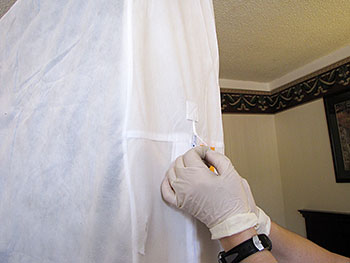
Figure 2.
- Bed Bug Traps. Zoom inMany bed bug traps are available to help detect bed bugs. Pitfall style traps such as shown in Figure 3 have been shown to be a cost-effective tool for detecting bed bugs and reducing bed bug bites while the infestation is being treated. Each trap costs a few dollars. A one-bedroom apartment may need about 8–12 traps. Placing traps under the furniture legs is more effective than visual inspection for detecting bed bugs. Traps can be placed beside the upholstered furniture if no furniture legs are present or the furniture legs are too large. A recent study shows traps alone detected 95% of the infestations in a building-wide bed bug inspection (Cooper et al. 2015). Placement of traps away from beds and furniture along the room perimeters and at the corners of rooms is also helpful in reducing bed bug infestations. Inspect the traps every 1–2 weeks to determine if bed bugs are still present and where they are distributed.
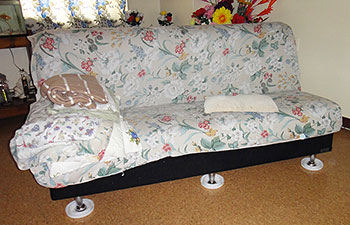
Figure 3.
- Frequent Laundering and Hot Drying. Drying cycles alone or in combination with washing with a hot water cycle are effective in killing bed bug eggs and mobile stages (Naylor and Boase 2010). Frequent washing or hot dyring is essential for eradicating bed bugs that are hiding in clothing, bed sheets, pillow cases, blankets, and other washable fabric materials. These items usually cannot be treated with insecticides.
- Containerized Heat Treatment. Zoom inNon-washable items such as shoes, elctronics, suitcases, etc. can be treated using a heat chamber. Several commercial heating boxes that cost about $200–350 are available for treating bed bug-infested items. For example, ZappBug Heater or ZappBug Oven 2 (zappbug.com) is a foldable heating box using regular outlets as the power source (Figure 4).
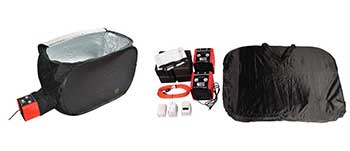
Figure 4. Left: ZappBug Heater; Right: ZappBug Oven 2
- Freezing. Another method for treating items that cannot be laudered is to freeze them. Household freezers usually have a temperature of -17.8°C (0°F). Small items such as shoes, telephones, and books can be de-bugged by wrapping them in plastic bags and placing them in a freezer for four days (Olson et al. 2013).
- Steam. Zoom inThe high temperature of steam (near 212°F or 100°C) will kill bed bugs instantly. A recent study shows both consumer-grade and professional-grade steamers can effectively kill bed bugs (Wang et al. 2018). A small steam machine (such as HAAN steam cleaning sanitizer) only costs about $75 (Figure 5). If frequent use or treatment of large areas is needed, a high capacity steamer that costs between $100–$1,300 is recommended. Apply steam along sofa seams, crevices and corners on bed frame, mattress edges, and corners where bed bugs may hide. A towel may be placed on the steamer head if there is concern that bed bugs may be blown away by the steam. Move the steamer slowly when bed bugs are hiding in cracks or behind fabric. Apply steam directly under the furniture to kill bed bugs that fell to the floor after treating the furniture. Reapply steam every few days until no bed bugs are found based on a combination of visual bed bug trap inspections. Be careful - steam may damage finished furniture surfaces and some fabrics such as microfiber.
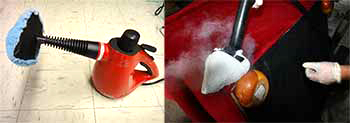
Figure 5. Left: HAAN HS-20R handheld steam cleaner; Right: Applying steam to a sofa.
- Zoom inVacuum. When large numbers of bed bugs are present, a vacuum machine can be used to quickly remove live and dead bed bugs and their shed skins. Place a knee-high stocking over the end of the vacuum tube and secure it with a rubber band prior to placing the attachment, to catch the bugs and prevent them from infesting the vacuum (Figure 6). Vacuum cracks and crevices including tufts, seams, zippers, and the trim of beds and upholstered furniture where bed bugs can hide. When you finish vacuuming, remove the stocking and discard in a sealed plastic bag. It should be noted that bed bug eggs or live bed bug nymphs and adults hiding in cracks may not be able to be removed by vacuuming.
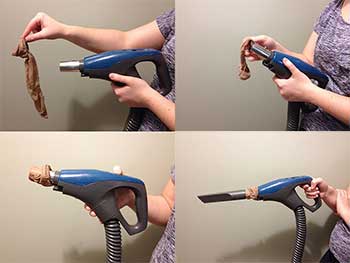
Figure 6.
- Disposal. Zoom inIt is usually unnecessary to dispose of furniture or personal belongings during bed bug treatment. However, heavily infested items and difficult-to-treat furniture may need to be disposed in some instances. For example, a heavily infested sofa with many bed bug hiding places is difficult to treat and inspect (Figure 7). Consider discarding severely infested furniture that is in disrepair or no longer wanted. If possible, replace wooden bed frames with metal bed frames in locations where bed bug problems are severe.
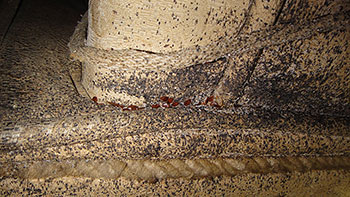
Figure 7.
- Repellents Containing DEET. Zoom inPreventing bed bugs is a primary concern for those who need to visit bed bug-infested homes. DEET treated fabric is repellent to bed bugs (Wang et al. 2013). Commercial insect repellents containing DEET for repelling ticks and biting insects are also helpful for preventing bed bugs when applied to outer surface of clothing (Figure 8). If the repellent product does not list bed bugs on the label, you should first check with your state pesticide regulatory agency to see if these repellents are allowed to be used for protection against bed bugs. It should be noted that DEET products cannot be used on furniture and should only be applied in a way that is consistent with the product label.
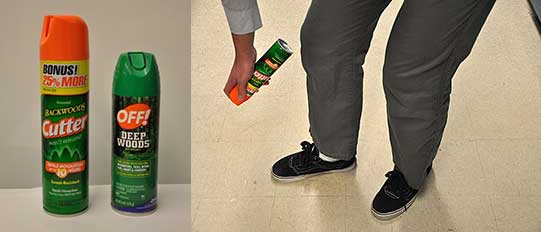
Figure 8.
Money-Wasting Bed Bug Control Materials and Methods (What Doesn't Work)
- Switching Sleeping Location. This method does not work because bed bugs can live in a vacant room for a few months without feeding. In addition, bed bugs can follow the carbon dioxide released by a human and migrate to the new sleeping location. Switching your sleeping location makes bed bug control more difficult because bed bugs are likely to become more widely-distributed throughout the home as a result.
- Ultrasonic Pest Repellers. Zoom inThere are abundant supplies of pest repeller products (Figure 9). North Arizona State University researchers examined four pest repellers (Yturralde and Hofstetter 2012). None of the repellers affected bed bug behavior. Ultrasonic pest repellents have not been shown to be useful for controlling bed bugs.
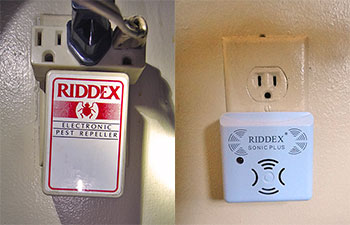
Figure 9.
- Dryer Sheets and Plant Oil-based Repellents. Zoom inSome consumers place dryer sheets on furniture in an attempt to repel bed bugs (Figure 10). Others use insect repellents containing pyrethroids or plant oils. There are no data indicating these products will prevent bed bug infestations.
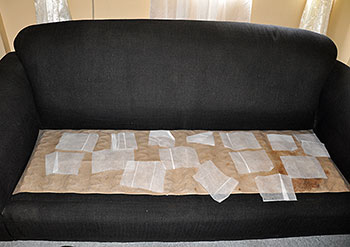
Figure 10.
- Moth Balls. Zoom inMoth balls are commonly used insecticides for repelling or killing fabric insects. Some consumers place moth balls under or around the bed or between the mattress and box spring for controlling or repelling bed bugs. Researchers at Rutgers University evaluated two moth ball products (Figure 11): IMS (99.8% paradichlorobenzone) and Enoz (99.5% naphthalene). Bed bug adults, nymphs, and eggs were placed throughout plastic bags filled with clothes, and the bags sealed. After one week, less than 50% of the bed bug adults had been killed, and the mothballs had no significant effect on bed bug eggs.
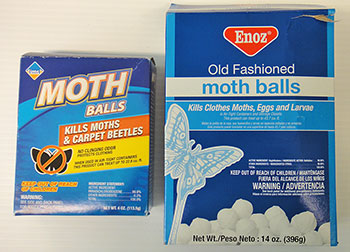
Figure 11.
- Rubbing Alcohol. Many web pages recommend using rubbing alcohol for bed bug control. The rubbing alcohol products available usually contain 70% or 91% isopropyl alcohol. Laboratory studies by Rutgers University show direct spray of either of these two products killed a maximum 50% of the bed bugs. In addition to their low efficacy, rubbing alcohol products are flammable materials, can create a fire hazard, and should not be used to control bed bugs.
- House Cleaning Materials. Zoom inSome people believe house cleaning sprays are useful for killing bed bugs. A number of multi-purpose cleaner (or disinfectant) products are used for controlling bed bugs. Rutgers University researchers tested a disinfectant product that is believed effective for controlling bed bugs (Figure 12). All bed bugs survived the direct spray treatment.
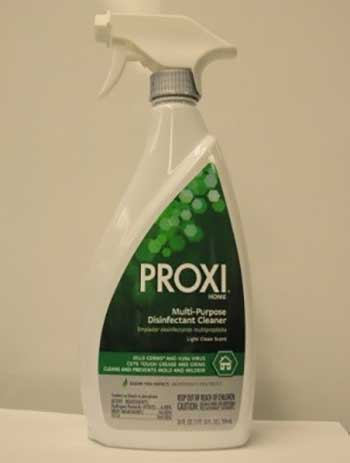
Figure 12.
- Most Natural Products and Detergents. There are numerous bed bug control products based on plant-derived materials or detergents. Unfortunately, most of them are ineffective (Singh et al. 2014). Of 11 tested products tested, only two (EcoRaider and Bed Bug Patrol) achieved more than 90% bed bug mortality when directly sprayed on bed bug nymphs under laboratory conditions. One product (EcoRaider) caused 87% egg death when directly sprayed to eggs. Other evaluated essential oil products had little to no effect on bed bug eggs.
- Foggers. Zoom inFoggers are widely used for controlling indoor pests. A study by Ohio State University indicates foggers are completely ineffective against bed bugs (Jones and Bryant 2012). Figure 13 shows a resident used nine foggers simultaneously in a studio apartment. Using nine foggers in a studio apartment poses a high risk of fire and personal injury. More importantly, it failed to eliminate the bed bugs.
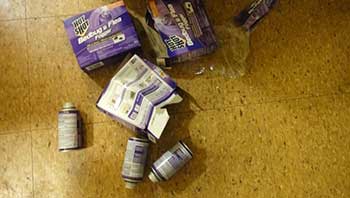
Figure 13.
- Pyrethroid Sprays. Pyrethroids are a class of insecticides commonly used for indoor pest control. Recent studies show the majority of the field bed bug populations are resistant to pyrethroids. The effectiveness of these products when used as the sole method of control is often very low due to prevalence of bed bug insecticide resistance.
Final Thoughts for Eliminating Bed Bugs
The most effective way to achieve bed bug elimination is to follow an integrated pest management (IPM) principle that includes monitoring, using a combination of several treatment methods, follow-up evaluation of the results, and re-treatment until elimination. After treatment, bed bug numbers become small and more difficult to find. To avoid premature termination of treatment, use a combination of visual inspection and bed bug monitors to detect bed bugs and confirm they are indeed eliminated. Stop treatment only when you cannot find bed bugs after using the above-mentioned methods for a month. When more than a few apartments are infested in a multi-unit dwelling, a building-wide approach will be necessary and will most likely require the experience of a pest management professional.
For more information about bed bugs, please visit the following websites: U.S. Environmental Protection Agency: epa.gov/bedbugs. Rutgers University: njaes.rutgers.edu/bed-bug.
Literature Cited
- Cooper, R., C. Wang, and N. Singh. 2015. Evaluation of a model community-wide bed bug management program in affordable housing. Pest Management Science 72: 45–56. DOI
- Jones, S. C., and J. L. Bryant. 2012. Ineffectiveness of over-the-counter total-release foggers against the bed bug (Heteroptera: Cimicidae). Journal of Economic Entomology 105: 957–963. DOI
- Naylor, R. A., and C. J. Boase. 2010. Practical solutions for treating laundry infested with Cimex lectularius (Hemiptera: Cimicidae). Journal of Economic Entomology 103: 136–139. DOI
- Olson, J. F., M. Eaton, S. A. Kells, V. Morin, and C. Wang. 2013. Cold tolerance of bed bugs and practical recommendations for control. Journal of Economic Entomology 106: 2433–2441. DOI
- Singh, N., C. Wang, and R. Cooper. 2014. Potential of essential oil-based pesticides and detergents for bed bug control. Journal of Economic Entomology 107: 2163-2170. DOI
- Wang, C. L., L. H. Lu, A. J. Zhang, and C. F. Liu. 2013. Repellency of selected chemicals against the bed bug (Hemiptera: Cimicidae). Journal of Economic Entomology 106: 2522-2529. DOI
- Wang, D. C. Wang, G. Wang, C. Zha, A. L. Eiden, R. Cooper. 2018. Efficacy of three different steamers for control of bed bugs (Cimex lectularius L.). Pest Management Science. DOI
- Yturralde, K. M., and R. W. Hofstetter. 2012. Efficacy of commercially available ultrasonic pest repellent devices to affect behavior of bed bugs (Hemiptera: Cimicidae). Journal of Economic Entomology 105: 2107-2114. DOI
Photo credits: Richard Cooper (Figure 2); ZappBug company (Figure 4); Karen Vail from University of Tennessee (Figure 6); Changlu Wang (all other figures).
Mention or display of a trademark, proprietary product, or firm in text or figures does not constitute an endorsement by Rutgers Cooperative Extension and does not imply approval to the exclusion of other suitable products or firms.
March 2019
Copyright © 2024 Rutgers, The State University of New Jersey. All rights reserved.
For more information: njaes.rutgers.edu.
Cooperating Agencies: Rutgers, The State University of New Jersey, U.S. Department of Agriculture, and Boards of County Commissioners. Rutgers Cooperative Extension, a unit of the Rutgers New Jersey Agricultural Experiment Station, is an equal opportunity program provider and employer.

